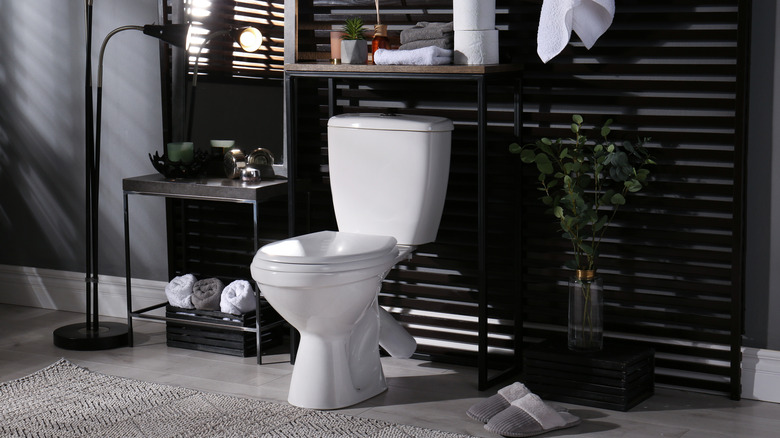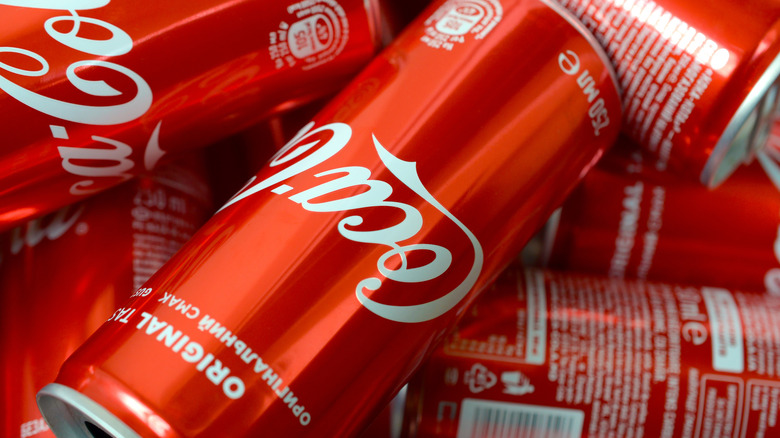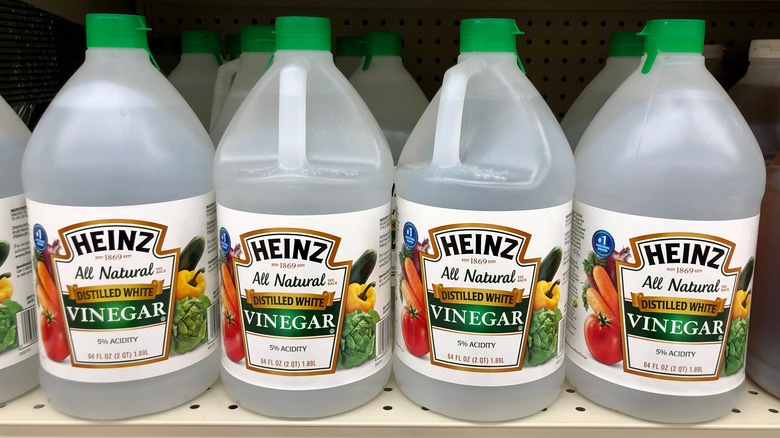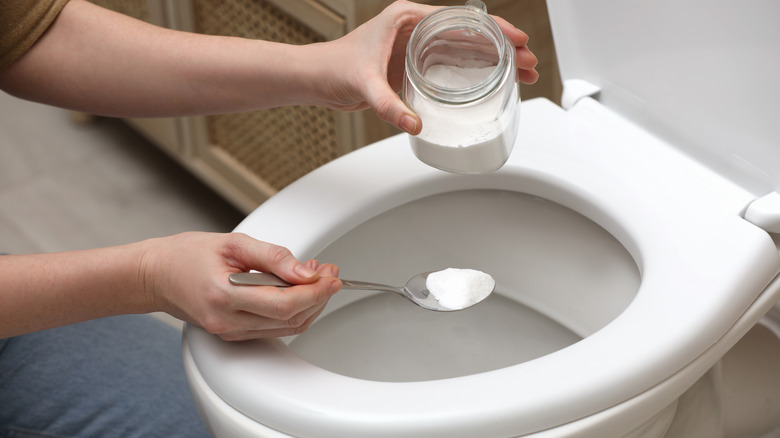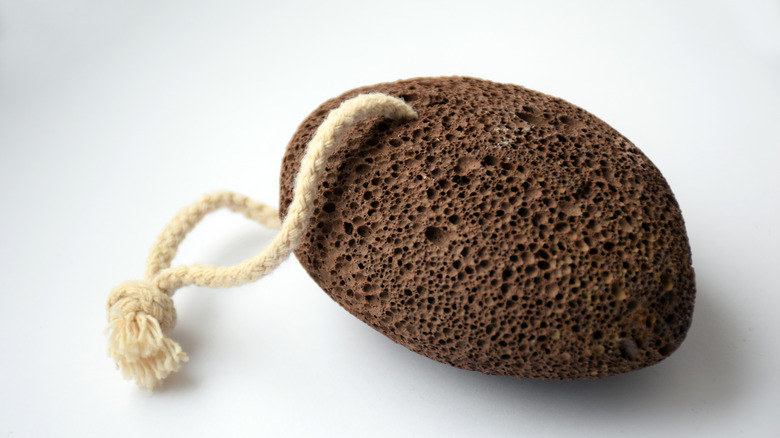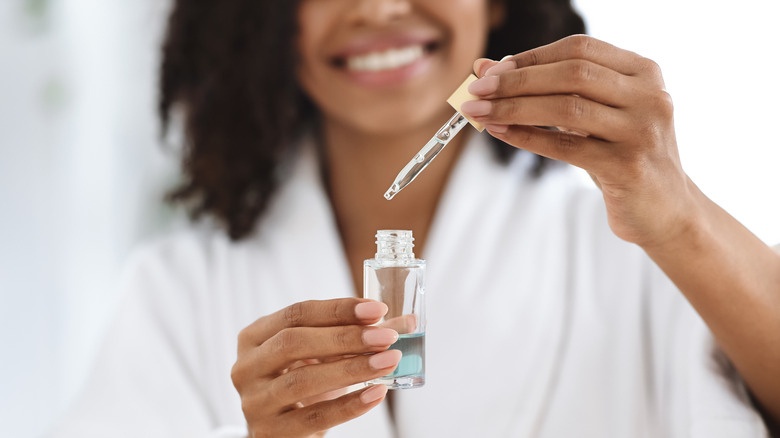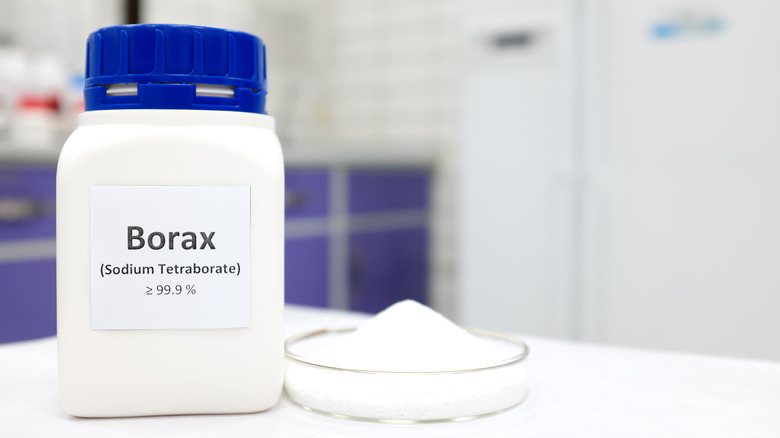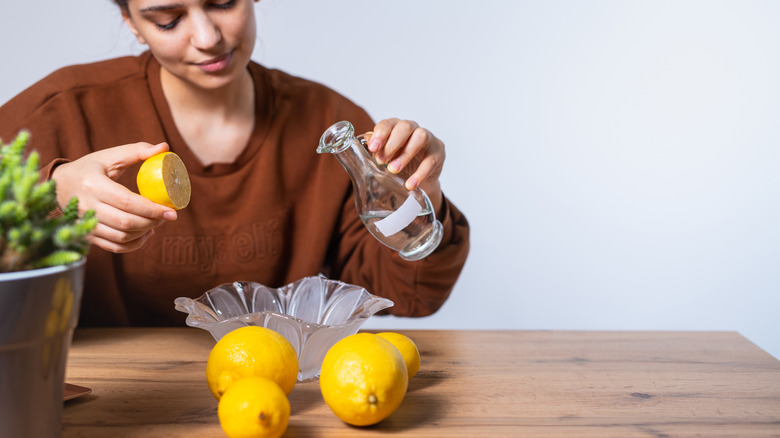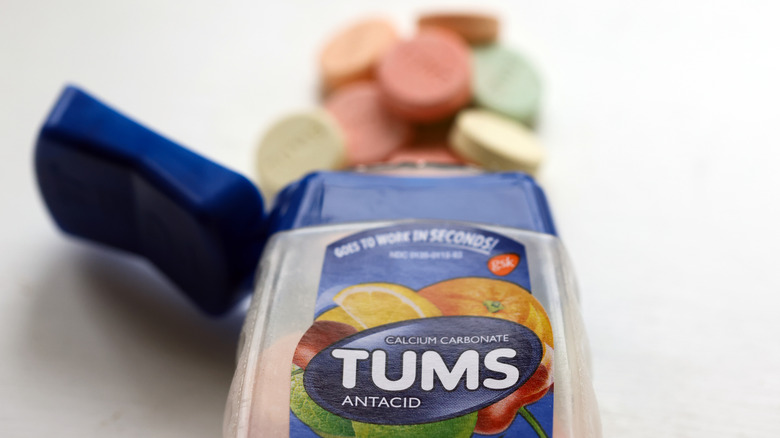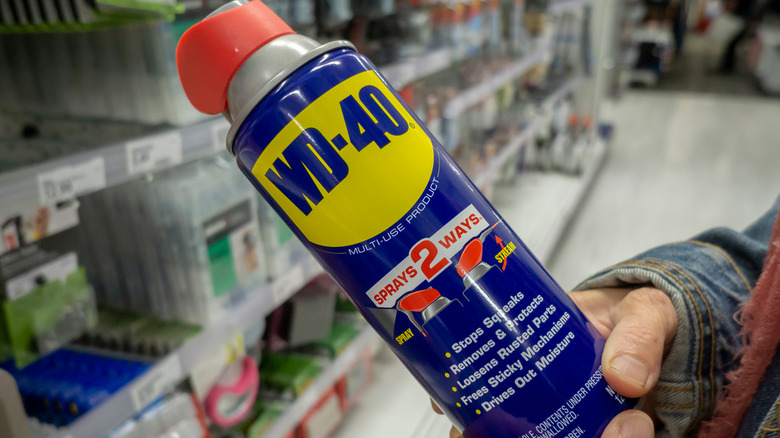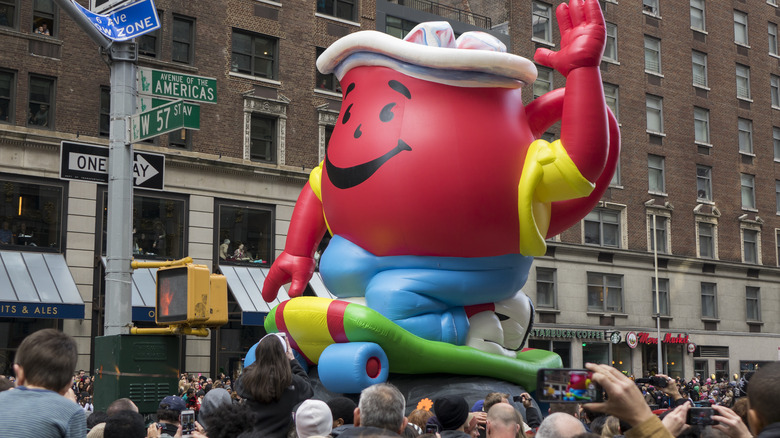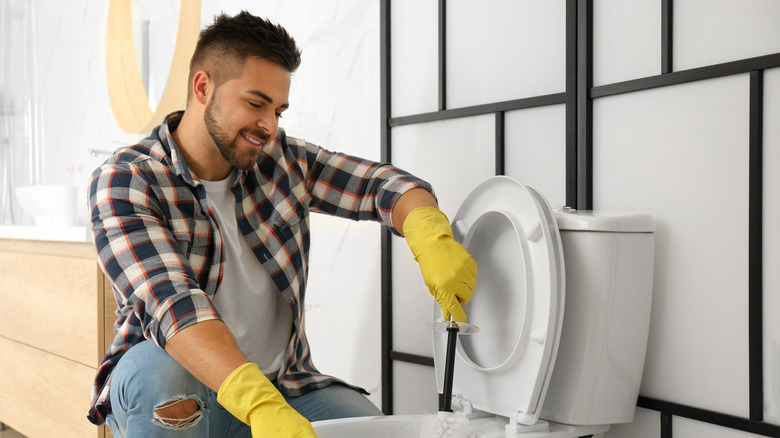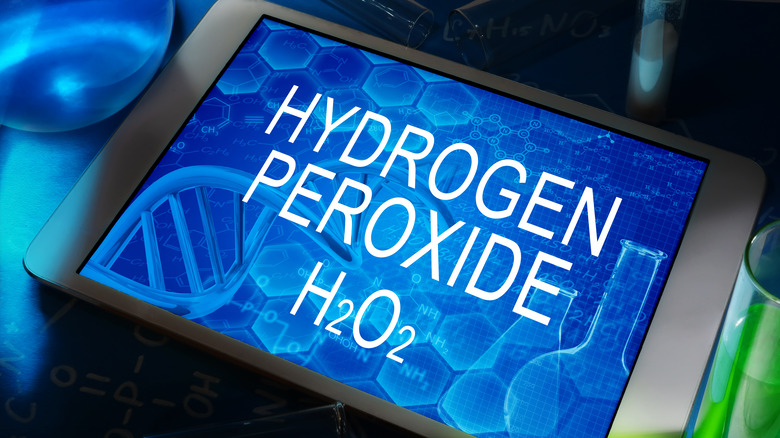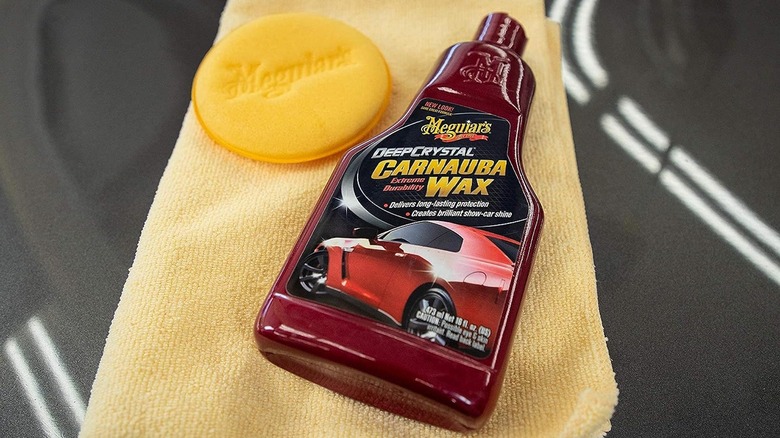We Put Common Household Items In The Toilet. Here's What Happened
We may receive a commission on purchases made from links.
Is your bathroom cleaning ritual stuck in a rut? Maybe it's time to shake it up with products from the most unlikely of places: your very own pantry or medicine cabinet. Coca-Cola, white vinegar, and Kool-Aid, for example, all have a use that extends far beyond their edible origin: They can spruce up toilets. And joy of joys, in some cases, there's no scrubbing — just a flush after soaking.
The importance of a clean toilet bowl is obvious: germ control. But have you thought about just how gruesome those toilet microbes can be? Flushing without closing the lid can contaminate everything exposed in your bathroom, including toothbrushes. The gross factor is multiplied when we consider where these germs are coming from. "Every gram of human feces contains billions and billions of bacteria, as well as viruses and even some fungi," Dr. Janet Hill told Today.
Experts say it's not necessary to disinfect daily, so you can give every product mentioned here a go. For a cleaner that smacks of a chemistry experiment, consider these common household items and what they can do for the potentially dirtiest seat in the house.
Use Coca-Cola and other sodas
Rust stains be gone: Folks swear by the power of Coke to eradicate stains including stubborn rust, and it's not a tall tale. Think of what we've been warned about soda rotting tooth enamel, a surface hard enough to last a lifetime, says Insider. That's because sodas contain both carbonic and phosphoric acids, a product of carbonation, says WikiHow. Because all sodas and even seltzer are carbonated, our toilet rescue need not involve Cola, but will work with any pop. If you put Coke in your toilet, the most featured toilet-bowl soda, do the trick at a bargain price. Because dirt-busting acid is in any soda, a store brand is likely to serve just as well. Experiment until you find one that meets your cleaning and budget needs.
When it's time to tackle the bowl, start with the rim and let the cola flow to cover all the stains, giving extra attention where needed. For die-hard residue, boost the soda's cleaning power by warming it in the microwave and then carefully targeting the bowl. The toilet's rust stains no doubt got there from daily exposure to iron often in hard water. This means you may have to exercise a little patience in banishing them from the bowl. That's why Insider encourages an overnight soak, and at the very least, resisting the temptation to flush for at least an hour.
Try putting vinegar in your toilet
For a clean toilet without harsh chemicals, try some white vinegar, especially on hard water stains. Another advantage? Soaking with vinegar can tackle stains overnight, often without scrubbing. Like the Coca-Cola, vinegar is a cleaning dynamo because it contains acid, in this case acetic acid — that's what gives it a sour taste and strong smell. The acid in vinegar has the strength to eliminate not only dirt and mineral deposits, but bacteria, which is never lacking in a toilet.
Want to clean your toilet with vinegar? It's probably as close as the kitchen pantry, ready to perform in salads or a marinade. The best vinegar to grab is white distilled with about 5% acidity, according to Healthline. Pour the vinegar on the sides and inside the bowl and wait about 30 minutes, using baking soda on a toilet brush to scrub any lingering stains, says HowStuffWorks. For hard water stains, green living expert Marc Lallanilla recommends spot cleaning overnight with toilet paper soaked in vinegar, as told to The Spruce. If the vinegar smell is overwhelming, try adding an essential oil like lemon, peppermint or lavender — fresh air also works so open a window or otherwise ventilate.
Apple cider vinegar, diluted with water or straight up for stains, works just as well, says Apartment Therapy, and is another item most folks are likely to have on hand. For foaming action, vinegar often partners with baking soda, another effective green cleaner.
Baking soda is an effective toilet cleaner
Want a homemade cleaner that's very friendly to pets and kids? Like the Cola and vinegar, baking soda is one of the safest ingredients folks have in the kitchen. A leavening agent, baking soda is what makes a chocolate cake light and airy — not hard as a rock. You can take baking soda straight up as an antacid for heartburn as well as indigestion, and it's an ingredient in many toothpastes. So, nothing toxic here (in small amounts).
That same cleaning power that gets your teeth white and shiny can go to work in your toilet, cleaning and deodorizing. Without harsh chemicals, baking soda eliminates debris, stains, and rings. It can also be teamed up with castile soap (a vegetable-oil-based soap) for a real power punch and a few drops of essential oil to disinfect. FYI, on its own baking soda won't fight germs like COVID-19, according to DIYNatural.
One recipe for a baking soda-based toilet bowl cleaner, featured on Family Handyman, combines all these ingredients in a homemade concoction. Save a little cash by recycling a dish-soap bottle and washing it out to keep your toilet bowl cleaner in. The recipe calls for 1/3 cup castile soap, 2 tablespoons of baking soda, 2 cups of water, and 5 drops each of lemon, eucalyptus, and lavender oils. (Oils smell fresh and battle germs.) According to this recipe, it's best to wait for the foaming action to subside before use.
Pumice stone can be good for your toilet
Pumice is volcanic rock, and anything formed from lava has got to be strong. It works on calluses and has a long history as a cleaning tool, so it's no surprise that a pumice stone is also tough on stubborn toilet bowl rings. Because pumice is rough textured glass, care should be taken to avoid scratching the bowl. The protocol described in The Spruce is to soak the pumice first in warm water, then make certain that both the stone and the bowl remain wet while cleaning. Scrub gently — this operation doesn't call for maximum elbow grease — until the stain disappears, and then flush to rinse.
Leslie Reichert, who tackled more than 11,000 toilets while in the cleaning business, told Today that the bowl should get the pumice stone treatment at least one a week. You'll want to wear rubber gloves, of course, because while pumice is one of the best tools out there for stains, it will mean close contact with the bowl. Use toilet cleaning powder where needed and then scrub.
To make this job a snap, Amazon sells long-handled pumice sticks designed for the gruesome task of toilet scouring. Like a toilet bowl brush, it puts a more comfortable distance between you and the grimy bowl.
Put essential oils in your toilet
Nature's powerhouse against germs and bacteria includes something you'd never imagine using to clean a toilet: essential oils. When it comes to cleaning, studies have focused on tea tree oil and determined that adding the oil to cleaners at a 0.5% to 1.0% concentration will kill the most bacteria, says DIYNatural. Tea tree oil is a triple threat, fighting bacteria, viruses, and fungi — but it is not the only bowl-beneficial oil. Lavender, rosemary, eucalyptus, thyme, lemon, orange, cinnamon, pine, and peppermint oil are all plant-based and therefore free of the harmful chemicals that can trigger allergies and asthma. Each have their own special qualities, some acting as disinfectants.
The internet is full of recipes for natural toilet bowl cleaner with essential oils, including one from Bob Vila that uses 2 cups of baking soda and approximately 1 teaspoon of a disinfecting essential oil. The mixing bowl must be glass since essential oil is tough on metal and plastic. The final ingredient, ½ cup of 20% white vinegar, will react with the rest — remember that volcano you made as a kid? — and should only be added in the toilet bowl. Note: This white vinegar is not the typical kitchen variety but can be purchased online.
Since essential oils, like peppermint, can also promote relaxation in the tub, muscles sore from a day of housecleaning can be revived in some cases with the same oil that freshened the bowl. Talk about versatility.
Borax can be used in your toilet
A common household cleaner, borax (sodium tetraborate) is also natural, which is why it's often called a green cleaner. This powdery white substance is mined from the earth and originates in dry lake beds like Death Valley, per the National Park Service. Its wide-ranging applications include everything from cosmetics and toothpaste to ant killer and laundry booster, and even toilet bowl cleaner.
With the power to bust stains and deodorize, borax turns up in numerous natural toilet bowl remedies. Yet just because it's natural doesn't mean borax is without any health risks. If inhaled or ingested, borax can cause organ damage and poisonings, Healthline advises. Experts say it would take large quantities to result in shock and organ damage, according WebMD, but swallowing smaller amounts can upset the stomach while breathing it in can hurt your nose, lungs, and nose. Note: Borax differs from boric acid, which is mainly used as a pesticide.
Many people do take precautions, such as rubber gloves, to safely use borax like they would other cleaning products. If borax is your choice for a shiny white bowl, here's how to use it: Sprinkle borax around the bowl and let it do the work overnight while you dream of waking up to no more grime. In the morning brush any lingering stains — they'll be gone in a snap, says HowStuffWorks.
Try putting lemon juice or citric acid in your toilet
In a pinch, lemon juice can spruce up your toilet bowl and possibly reduce hard water stains. Lemon juice contains citric acid, a magnet of sorts for toilet bowl debris, and therefore helps in bathroom cleanups. Citric acid is a compound derived naturally from lemon and other citrus fruits, and while not hazardous to humans, it is tough on germs. In fact, it kills bacteria, mildew, and certain fungi, according to The Spruce.
A popular green cleaner, lemon juice contains 5% to 8% citric acid. The scent is also more pleasant than natural cleaners like rubbing alcohol and white vinegar. So maybe you'll clean a little longer — and get a sparkling house to go along with your sparkling bowl. Got stubborn rust stains? Then perhaps it's time to call in the big guns: lemon juice and a laundry booster mixed to make a paste, recommends HowStuffWorks.
Fresh lemons can also be used to make a homemade cleaning product that can tackle the toilet and much more. However, lemons are not the only fruit that can go to bat for you in household cleaning. That citric acid boost also comes from limes, oranges, grapefruit, strawberries, and pineapples — more than enough variety to break out of your cleaning rut for a while and maybe be inspired to eat healthy on your break.
Denture or antacid tablets are effective toilet cleaners
Run out of toilet bowl cleaner right before the guests arrive and you just might appreciate wearing dentures or a nightguard. When in a jam, a few denture tablets can put their fizz action to work in your toilet, setting the stage for scrubbing. Antacids work the same way. According to Reader's Digest, all it takes is one denture tablet with baking soda or two antacid tablets. Drop them into the bowl and allow about 20 minutes to dissolve before finishing the job with your trusty toilet brush. Others recommend a few denture tablets and waiting for the fizz to stop before scrubbing. Without the toxins, the tablets have all the strength of a store-bought cleaner at a significant savings, says The Spruce.
Those who battle daily with hard water stains will want to stock up on their denture tabs. According to Apartment Therapy, denture tablets are a great weapon in the fight against these stubborn stains.
Don't flush WD-40 down your toilet
It's not exactly a pantry item, but WD-40 is a household staple and a remedy for so many of life's problems it would take the rest of this article to name them all. It can remove chewing gum, break in a ball glove, clean carpet stains, waterproof boots, and even keep squirrels from bird feeders, to name a few, says Family Handyman. One not to overlook is eradicating the rust and black stains caused by bacteria in your toilet, according to the company website. Exactly what's in WD-40 is a company secret, but we do know it's a blend of lubricants and contains anti-corrosive agents and ingredients for penetration, water displacement, and soil removal.
The hack for using WD-40, and reaping its power to soften rust and lime deposits, is to go sparingly with the product in your toilet. The three steps are: Spray the problem area, let it sit for one or two minutes, and whisk away with a toilet brush. Take caution not to flush the product down the toilet, as it's not safe for septic tanks. This cleaning is best done with just spraying and wiping to remove stains and deodorize. For that fresh clean smell, go with the low-odor version. Your toilet will last longer and retain its shine without toxic chemicals and excessive scrubbing
Yes, Kool-Aid and Gatorade will clean your toilet
While it sounds strange to use Kool-Aid or Gatorade to clean a toilet bowl, the power these drinks pack is true science and stems from the citric acid both contain. The citric acid in Gatorade makes it not just an energy sports drink, but also an affordable toilet bowl cleaner. 2 cups do the trick for set-in stains; for best results, don't flush for an hour. The lemonade- or orange-flavored Kool-Aid can get the job done for the same reason — that citric acid, says Florida-based Conyers Plumbing. It's particularly tough on hard water rings and mineral deposits. Just open a packet and sprinkle into the bowl using the toilet brush to mix it up, says Conyers. Then wait preferably overnight before flushing your toilet stain troubles away.
As a refreshing drink Kool-Aid hits the spot in any flavor, but for the toilet bowl, stick to the lemon or orange to take advantage of the citric acid. From a price standpoint, Kool-Aid also has many store-bought cleaners beat. You'll probably only need one packet, costing under a dollar, to wipe out toilet bowl stains, recommends Conyers. Not a big fan of pouring Kool-Aid or sports drinks in the potty? Citric acid can be purchased as a powder and added to the bowl — about 3 tablespoons does the trick, says Utopia.
Try putting rubbing alcohol in your toilet
Most medicine cabinets contain rubbing alcohol, but did you know it can kill germs not only on the skin, but also in the toilet? A good soak in the bowl for a few minutes and toilet germs have had their day, because rubbing alcohol is not just a cleaner, but a disinfectant powerful enough to fight the flu. But don't use the rubbing alcohol full strength; dilute the solution with 1 part water for every 2 parts of alcohol, says WikiHow. To benefit fully from this germicide, avoid watering it down too much. To make this hack a snap, use a spray bottle to attack the entire bowl, especially stains and rings. Wait a few minutes and then brush away the stains, says HuffPost.
Working with such a powerful disinfecting agent requires precautions — like opening windows to control potentially harmful fumes, says Apartment Therapy. Other warnings are: Never, ever mix with bleach because that would a create toxic chemical, and keep away from flames to prevent a fire. Yes, rubbing alcohol is considered highly flammable, so don't smoke and clean the toilet, not that you would. And break out those trusty rubber gloves to guard your hands from harsh exposure.
Mouthwash is a great way to freshen your toilet
Not only does it produce minty breath, but mouthwash can double as a fresh-smelling toilet bowl cleaner. It might sound strange, but think about it. Mouthwash freshens breath and kills germs, too, having evolved from a surgical antiseptic. Why not unleash the power in the toilet bowl, which also needs to battle odor and germs? Soak 1/4 cup for a half hour, as recommended, then go ahead and scrub, says Reader's Digest. According to AARP, the hack is using a mouthwash that contains alcohol, which we know to be a strong cleaner, especially during COVID-19.
Even when the bowl is clean, mouthwash can give the room a fresh smell — it works to treat bad breath, why not a dingy toilet? Mouthwash may not be your go-to product for bathroom cleaning, but in a pinch, you can freshen your breath and your bowl.
Hydrogen peroxide is a trusty toilet cleaner
You've probably heard that hydrogen peroxide is fierce against germs, but you may not have imagined this medicine cabinet staple in the toilet bowl. Break out of your cleaning mold and disinfect the bowl with 1/2 cup of peroxide, letting it sit for 30 minutes, advises The Spruce. Just how powerful is peroxide? This antiseptic is on the list of cleaners effective on viruses harder to kill than COVID-19, says WebMD. Although it hasn't been tested specifically against the novel coronavirus, peroxide means business. Dr. Sarah Pickering Beers explained to the Cleveland Clinic that hydrogen peroxide would be water if not for the oomph it gets from an added oxygen molecule (H202). When this extra molecule oxidizes, peroxide gains its strength because oxidation destroys germs.
To get the most out of this anti-bacterial weapon, Bob Vila suggests targeting the bowl with hydrogen peroxide at least once a week, scrubbing with a toilet brush after a 30-minute soak. The brush can also be freshened with a little peroxide on the bristles, but let them dry before returning to the holder.
So add hydrogen peroxide to the abundance of household items that can dash dirt and germs in the toilet. So handy and often budget friendly, they all come with one major drawback: There might never be an excuse to put off cleaning the toilet, even if that's the chore you most despise.
Car wax makes a toilet sparkle like new
Any vehicle owner knows that car wax is an essential ingredient to making your automobile glisten. Made of a synthetic blend of carnauba and beeswax, natural oils, and petroleum distillates, this formula leaves a protective film over paint jobs that restores their original shine and appearance. Even though this formula is purposed for car exteriors, it's applicable for many surfaces where you want to create the same shiny effect.
In fact, you can use car wax in your toilet to brighten and restore its appearance. Start by giving the bowl a good cleaning, and ensure that the inside is clear of grimy residue. Once it's been scrubbed clean, shut off your water supply and flush all remaining water from the toilet bowl. Use a cotton rag or paper towel to rub the inside of the bowl until it's dry, and you should be ready to apply the wax. Depending on which brand you use, the directions for application can vary. As a general rule, you should use gentle but steady pressure, rubbing the wax in circular motions around the inside of the bowl. Allow the bowl to completely air-dry before you turn your water supply back on and refill the toilet.
The ending result should be a shiny, new-looking toilet. In about three months, pour a half cup of white vinegar into the bowl to renew the coating. This helps prevent toilet rings from forming over the wax coating and is less harsh on septic systems than more corrosive cleaners.
